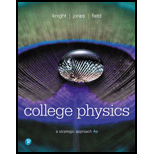
The heating element of a simple heater consists of a 2.0-m-long, 0.60-mm-diameter nichrome wire. When plugged into a 120 V outlet, the heater draws 8.0 A of current when hot.
a. What is the wire’s resistance when it is hot?
b. Use your answer to part a to calculate the resistivity of nichrome in this situation. Why is it not the same as the value of ρ given for nichrome in Table 22.1?
Want to see the full answer?
Check out a sample textbook solution
Chapter 22 Solutions
College Physics: A Strategic Approach Plus Mastering Physics with Pearson eText -- Access Card Package (4th Edition) (What's New in Astronomy & Physics)
Additional Science Textbook Solutions
Microbiology: An Introduction
Anatomy & Physiology (6th Edition)
Organic Chemistry (8th Edition)
Microbiology: An Introduction
Chemistry: Structure and Properties (2nd Edition)
Campbell Biology: Concepts & Connections (9th Edition)
- Two objects (m₁ = 4.75 kg and m₂ 2.80 kg) are connected by a light string passing over a light, frictionless pulley as in the figure below. The 4.75-kg object is released from rest at a point h = 4.00 m above the table mg m (a) Determine the speed of each object when the two pass each other. m/s (b) Determine the speed of each object at the moment the 4.75-kg object hits the table. m/s (c) How much higher does the 2.80-kg object travel after the 4.75-kg object hits the table? marrow_forwardA cell of negligible internal resistance is connected to three identical resistors. The current in the cell is 3.0 A. The resistors are now arranged in series. What is the new current in the cell?arrow_forwardA negatively charged sphere is falling through a magnetic field. north pole of magnet direction of motion south pole of magnet What is the direction of the magnetic force acting on the sphere?arrow_forward
- Electrons in a conductor are moving down the page. A proton outside the wire is moving to the right. What is the direction of the magnetic force acting on the proton?arrow_forwardWhat is the resistance of an ideal voltmeter and the resistance of an ideal ammeter? Resistance of an ideal voltmeter Resistance of an ideal ammeter infinite A. zero B. zero zero C. infinite infinite D. infinite zeroarrow_forwardvariable resistor with a resistance range of 0 to 6.0 KQ is connected in series with two resistors of fixed value 6.0 KQ. The cell in the circuit has an emf of 18 V and a negligible internal resistance. 18 V X Y 6.0 ΚΩ 6.0 ΚΩ 0 - 6.0 ΚΩ What is the maximum range of potential difference that can be observed between X and Y?arrow_forward
- A positive point charge of magnitude 1.0 μC and a point charge q are separated by a distance d. electron 1.0 με An electron is placed at a distance d from the +1.0 μC charge. The electric force on the electron is zero. What is q?arrow_forwardTwo point charges of +4q and -q are placed a fixed distance apart. Where is the electric field strength equal to zero? B. +49 D. A network of three resistors is connected to a cell of emf 12V and internal resistance R of 2.0 Q as shown.arrow_forwardThree point charges of equal magnitude are placed at the vertices of an equilateral triangle. The signs of the charges are shown. Point P is equidistant from the vertices of the triangle. What is the direction of the resultant electric field at P? B.arrow_forward
- A magnetic force per unit length F acts on P due to Q. The distance between the wires is increased to 2d and the current in Q is decreased to 1/2. P Q P 12 2d What is the magnetic force per unit length that acts on P due to Q after the changes?arrow_forwardAn electric field is established between two electrodes separated by distance d, held at a potential difference of V. A charged particle in this field experiences a force F. What is the charge on the particle?arrow_forwardCurrent / flows in a conducting wire. What expression correctly gives the number of electrons passing through a cross section of the wire in a time t?arrow_forward

 College PhysicsPhysicsISBN:9781305952300Author:Raymond A. Serway, Chris VuillePublisher:Cengage Learning
College PhysicsPhysicsISBN:9781305952300Author:Raymond A. Serway, Chris VuillePublisher:Cengage Learning College PhysicsPhysicsISBN:9781285737027Author:Raymond A. Serway, Chris VuillePublisher:Cengage Learning
College PhysicsPhysicsISBN:9781285737027Author:Raymond A. Serway, Chris VuillePublisher:Cengage Learning College PhysicsPhysicsISBN:9781938168000Author:Paul Peter Urone, Roger HinrichsPublisher:OpenStax College
College PhysicsPhysicsISBN:9781938168000Author:Paul Peter Urone, Roger HinrichsPublisher:OpenStax College Principles of Physics: A Calculus-Based TextPhysicsISBN:9781133104261Author:Raymond A. Serway, John W. JewettPublisher:Cengage Learning
Principles of Physics: A Calculus-Based TextPhysicsISBN:9781133104261Author:Raymond A. Serway, John W. JewettPublisher:Cengage Learning Physics for Scientists and EngineersPhysicsISBN:9781337553278Author:Raymond A. Serway, John W. JewettPublisher:Cengage Learning
Physics for Scientists and EngineersPhysicsISBN:9781337553278Author:Raymond A. Serway, John W. JewettPublisher:Cengage Learning





